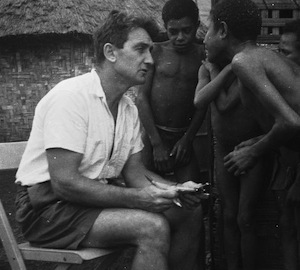About Pollex Online
What is Pollex Online?

Courtesy of the Anthropology Photographic Archive
POLLEX-Online is a large-scale comparative dictionary of Polynesian languages.
POLLEX was started in the 1960s by Bruce Biggs at the University of Auckland, New Zealand.
Biggs obtained funding for POLLEX through a New Zealand Government Lottery Grant, and a National Science Foundation Grant to the Bernice P. Bishop Museum. This project was first published as a monograph in 1966 (Biggs and Walsh 1966), and a series of subsequent manuscripts and working papers (Biggs, Walsh and Waqa 1970, Biggs 1976, Biggs 1979), before being distributed as a «computer file». Biggs worked on this project until his death in 2000 (Pawley 2001), when it was handed over to Ross Clark.
If you use the POLLEX-Online database, please cite: Greenhill SJ & Clark R (2011). POLLEX-Online: The Polynesian Lexicon Project Online. Oceanic Linguistics, 50(2), 551-559.
Distribution Codes
The head line begins with a two-letter code (preceded by dot) indicating the distribution of cognates belonging to the set. In earlier versions of POLLEX, these codes corresponded to subgroups in the comparative linguistic sense (sets of languages sharing a common ancestor separate from the rest of the family). The following abbreviations were used:
- AN — Austronesian
- CE — Central-Eastern Polynesian
- CP — Central Pacific
- EC — Ellicean
- EO — Eastern Oceanic
- EP — East Polynesian
- FJ — Fijic
- MP — Malayo-Polynesian
- MQ — Marquesic
- NP — Nuclear Polynesian
- OC — Oceanic
- PN — Polynesian
- SO — Samoic-Outlier Polynesian
- TA — Tahitic
It will be noted that among these are some groups which form part of the Polynesian family (such as Central-Eastern Polynesian) and others which include Polynesian as a part (such as Oceanic). In the first case, the interpretation of the distribution code is simple: ".CE", for example, means that the form shown has reflexes only within the Central-Eastern languages, and is therefore reconstructed for Proto Central Eastern (PCE). Where the distribution code refers to a group that includes Polynesian, however (in the above list, AN, CP, EO, FJ, MP and OC), the interpretation is slightly different: ".OC", for example, means that the form shown in the head line is reconstructed as Proto-Polynesian (PPN), but can be regularly derived from an earlier, Proto-Oceanic (POc) form. The actual reconstructed forms for higher-level languages such as POc are normally given below the head line in lines marked *2 - *6.
Regarding SO: "the quantity and quality of probable shared innovations is considerably below that needed to establish a subgroup." (Pawley 1967:286).
Regarding the postulated subgroup EC: This includes ECE, TAK, OJA, SIK, NKM, NKR, NKO, KAP, (i.e. the Northern Outliers and the Equatorial Outliers).
And note the revised subgrouping proposed by Marck (1999).
When distribution of cognates did not correspond clearly with the limits of any known subgroup, frequent use was made of "??" in place of the subgroup code. In the present version I have tried to eliminate most of these. A few have been assigned (more or less hopefully) to established subgroups. Others follow certain recurrent patterns of distribution which probably do not correspond to subgroups (borrowing is probably involved), but which at least localize the word with Polynesian. These begin with an "X" as a warning that they are not proposed as subgroups:
- XE — Marquesan, Mangarevan and Easter Island (MQA MVA EAS)
- XO — Outliers (NKO KAP NGR TAK NKM OJA SIK PIL REN TIK ANU MAE MFA WFU WEV)
- XW — West Polynesia (TON,NIU,EUV,EFU,SAM,TOK,TUV,NFO)
Some other (proposed) notations for even more restricted sets:
- ZA — Anuta + Tikopia
- ZF — E Futuna + Samoan
- ZK — Nukuoro + Kapingamarangi
- ZR — Tahitian + Rarotongan
- ZS — Samoan + Tokelauan
- ZT — Tahitian + Rarotongan
- ZU — Tongan + E Uvean
Alphabetical Order
The following letters are used for transcription of proto-forms:
A E F G H I K L M N O P Q R S T U V W

